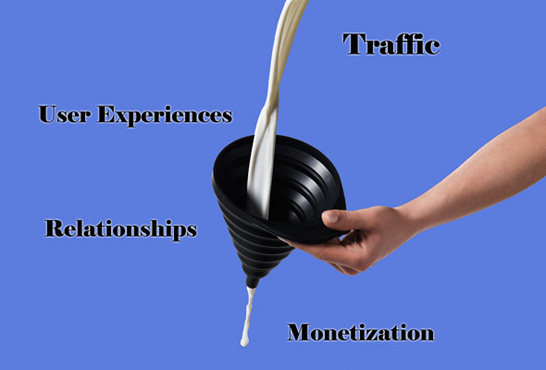
Any website or online business that exists for any purpose beyond self expression has a set of conversions that drive its success. Just like any traditional sales process, online success can be measured as a series of conversions that resemble a funnel. A large number of “targets” or “prospects” is driven into a process of steps that narrow their number down and down until the last remaining targets turn into whatever goal the driver has in mind…customers…users…readers, etc.
This process is often best represented as a funnel, with the large top section getting narrower and narrower with each step, as the pool of targets diminishes with the loss of those who did not “convert” from step to step. Some funnels are short and go right to the ultimate end conversion. Others are taller and multi-stepped, with a more gradual buildup of connection between the user and the site, service, or product.
Why is this important? Well one of the best things about online marketing is the ability to measure success quantitatively and adjust your approach to improve results. When your task is something as large as turning the denizens of the wider internet into customers for your product or service, that is not a single conversion or a single measurement. Rather, most strategies involve many steps and inputs, each of which can be optimized for its greatest contribution to ultimate success. Funnel analysis is a very useful way of breaking down a complex set of drivers into ultimate success and examining the success of each factor. When comparing the metrics for each step to industry standards and to themselves over time or under one approach versus another, online marketers gain a framework for doing their work, applying scarce resources, and seeing where they might have the biggest impact by applying change.
This is the first in a series of posts that will examine the various steps of the online funnel, the metrics that are generally measured for each step, and the tactics that are employed at each step. There are as many different funnels as there are businesses or site publishers on the internet. For our purposes however, we will look at the funnel as consisting of four primary stages prior to ultimate monetization:
1. Traffic driving
2. User engagement
3. Relationship building
4. Monetization events (AKA Purchase decisions)
In its most basic framework, this involves single conversion metrics leading from step to step.
1. Converting measures of traffic to some action on a site or using a service.
2. Moving from a single interaction to a repeated one.
3. Moving from a set of interactions to the consideration of a purchase (for example).
4. Consummating monetization (through a purchase, click-through, or otherwise).
In our next post in the series, we will look at the tactics used in the first funnel step, driving traffic, and the drivers and metrics that lead to conversion from that step to measuring the movement to the second funnel step, user engagement.
Image adapted from original by Normann Copenhagen.
